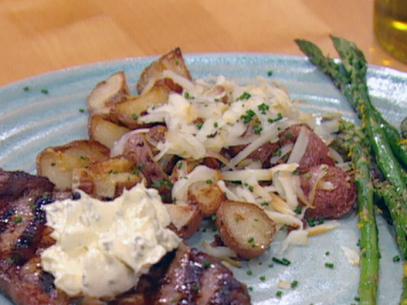
Red Wagon Pizza
- Level: Intermediate
- Total: 3 hr 40 min (includes resting and rising time)
- Active: 1 hr
- Yield: 2 servings (1 pizza)
- Level: Intermediate
- Total: 3 hr 40 min (includes resting and rising time)
- Active: 1 hr
- Yield: 2 servings (1 pizza)
Ingredients
Directions
Special equipment:
a pizza stone- Pour the flour, water and yeast into the bowl of a stand mixer and mix for 2 1/2 minutes. Scrape the bottom of the bowl and mix for another 2 1/2 minutes. Throw 1 tablespoon sea salt on top of the mixed dough; cover with plastic wrap and let rest for 30 minutes. After the dough rests, return to the mixer and mix in 1-minute increments until the dough passes a window test to verify gluten development (see Cook's Note).
- Once gluten development is verified, leave the dough in the mixing bowl, cover and place in the refrigerator until it doubles in size, about 2 hours.
- While the dough is doubling, pour the crushed tomatoes and whole tomatoes into a food processor. Add the oregano, crushed red pepper and garlic salt and process until smooth. Cover and place in the refrigerator until ready to use.
- Place a pizza stone in the oven and preheat the oven to the highest temperature it will allow (500 to 550 degrees F; never set it to broil).
- Drain the banana peppers. Chop them roughly and set aside.
- Grate the mozzarella and provolone, and toss them together in a large bowl.
- Once the dough has doubled in size, divide it into approximately three to four 9-ounce balls. Take 1 ball and reserve the remaining for another use. In the palm of your hand, rotate the ball of dough in a circular pattern until the top of the ball is smooth. Don't be afraid of the dough ball. If you mess up, just knead the dough and wait for it to rise and try again. Throw some flour down on a clean, dry surface and press the dough ball flat. Once the ball is flat, focus on the edges of the ball by pressing the edge completely flat against the work surface. This will leave a higher point in the center of the dough ball. Now, flip the dough ball over and slowly start to stretch the dough a little at a time from the edge while pushing down slightly in the middle. Again, don't be afraid: if you mess up, just ball up the dough and wait for it to rise, and try again.
- The dough should be shaped into a 12- to 14-inch round. Place the round on a flour-dusted pizza peel or cutting board. Ladle some of the tomato sauce onto the dough and float the bottom of the ladle over the dough until the sauce reaches roughly 1/2 inch away from the edge. Do not go over the edge: the sauce will make it difficult for the dough to slide off the peel. Reserve the remaining sauce for another use.
- Lightly sprinkle the cheese blend over the sauce, being certain to cross the sauce-dough line; this is called anchoring the cheese. You will still want to see some of the sauce through the cheese. Avoid putting too much on; it should be like a screen of cheese.
- Crumble some uncooked Italian sausage and sprinkle it evenly onto the pizza. Then sprinkle on some banana peppers.
- This next step is important: Take your ribbons of sopressata and curl them into an 'S' shape so they can stand upright, allowing the top of the sopressata to cook faster than the cheese.
- When building your Red Wagon Pizza, always think of the architecture of the pizza and how it will be cut and eaten. This will help you avoid having slices with no ingredients on them.
- Slide the pizza onto the pizza stone. If it is not sliding, lift the edge and gently blow on the flour to get the dough to float then slide it onto the pizza stone. Bake, checking the pizza occasionally, until the cheese is golden brown and the crust is cooked through, about 8 minutes. Remove the pizza from the oven and place it onto a cooling rack to cool for 1 to 2 minutes. Slide it onto a cutting board, cut and enjoy!
Cook’s Note
Weigh the flour and water for the crust; do not work by volume. The window test is the best way to tell if you've mixed your dough sufficiently. Cut off a piece of dough about the size of a golf ball. Hold it between your thumb and first two fingers. Gently spread your thumb and fingers apart. Stretch the dough until you obtain a thin, translucent 'windowpane.' If you can stretch the dough without it breaking, then the gluten is well developed and your dough is ready to rise. Put the ball back into the larger batch and allow it to rise. However, if the dough tears before you've fully extended your fingers, the gluten isn't quite ready yet. Continue to mix the dough in 1-minute increments, and repeat the window test.
































